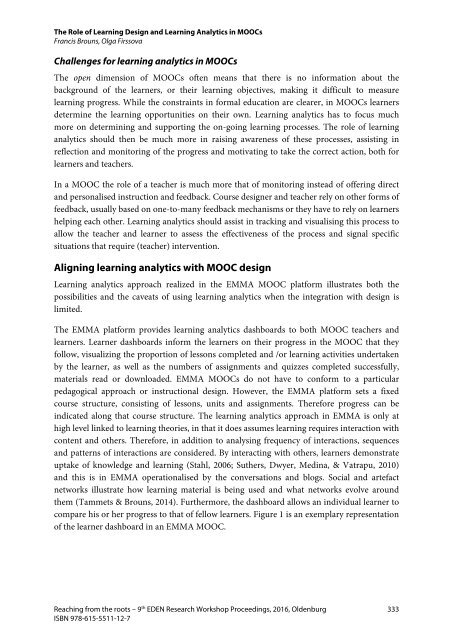Forging new pathways of research and innovation in open and distance learning
RW_2016_Oldenburg_Proceedings
RW_2016_Oldenburg_Proceedings
Create successful ePaper yourself
Turn your PDF publications into a flip-book with our unique Google optimized e-Paper software.
The Role <strong>of</strong> Learn<strong>in</strong>g Design <strong>and</strong> Learn<strong>in</strong>g Analytics <strong>in</strong> MOOCs<br />
Francis Brouns, Olga Firssova<br />
Challenges for learn<strong>in</strong>g analytics <strong>in</strong> MOOCs<br />
The <strong>open</strong> dimension <strong>of</strong> MOOCs <strong>of</strong>ten means that there is no <strong>in</strong>formation about the<br />
background <strong>of</strong> the learners, or their learn<strong>in</strong>g objectives, mak<strong>in</strong>g it difficult to measure<br />
learn<strong>in</strong>g progress. While the constra<strong>in</strong>ts <strong>in</strong> formal education are clearer, <strong>in</strong> MOOCs learners<br />
determ<strong>in</strong>e the learn<strong>in</strong>g opportunities on their own. Learn<strong>in</strong>g analytics has to focus much<br />
more on determ<strong>in</strong><strong>in</strong>g <strong>and</strong> support<strong>in</strong>g the on-go<strong>in</strong>g learn<strong>in</strong>g processes. The role <strong>of</strong> learn<strong>in</strong>g<br />
analytics should then be much more <strong>in</strong> rais<strong>in</strong>g awareness <strong>of</strong> these processes, assist<strong>in</strong>g <strong>in</strong><br />
reflection <strong>and</strong> monitor<strong>in</strong>g <strong>of</strong> the progress <strong>and</strong> motivat<strong>in</strong>g to take the correct action, both for<br />
learners <strong>and</strong> teachers.<br />
In a MOOC the role <strong>of</strong> a teacher is much more that <strong>of</strong> monitor<strong>in</strong>g <strong>in</strong>stead <strong>of</strong> <strong>of</strong>fer<strong>in</strong>g direct<br />
<strong>and</strong> personalised <strong>in</strong>struction <strong>and</strong> feedback. Course designer <strong>and</strong> teacher rely on other forms <strong>of</strong><br />
feedback, usually based on one-to-many feedback mechanisms or they have to rely on learners<br />
help<strong>in</strong>g each other. Learn<strong>in</strong>g analytics should assist <strong>in</strong> track<strong>in</strong>g <strong>and</strong> visualis<strong>in</strong>g this process to<br />
allow the teacher <strong>and</strong> learner to assess the effectiveness <strong>of</strong> the process <strong>and</strong> signal specific<br />
situations that require (teacher) <strong>in</strong>tervention.<br />
Align<strong>in</strong>g learn<strong>in</strong>g analytics with MOOC design<br />
Learn<strong>in</strong>g analytics approach realized <strong>in</strong> the EMMA MOOC platform illustrates both the<br />
possibilities <strong>and</strong> the caveats <strong>of</strong> us<strong>in</strong>g learn<strong>in</strong>g analytics when the <strong>in</strong>tegration with design is<br />
limited.<br />
The EMMA platform provides learn<strong>in</strong>g analytics dashboards to both MOOC teachers <strong>and</strong><br />
learners. Learner dashboards <strong>in</strong>form the learners on their progress <strong>in</strong> the MOOC that they<br />
follow, visualiz<strong>in</strong>g the proportion <strong>of</strong> lessons completed <strong>and</strong> /or learn<strong>in</strong>g activities undertaken<br />
by the learner, as well as the numbers <strong>of</strong> assignments <strong>and</strong> quizzes completed successfully,<br />
materials read or downloaded. EMMA MOOCs do not have to conform to a particular<br />
pedagogical approach or <strong>in</strong>structional design. However, the EMMA platform sets a fixed<br />
course structure, consist<strong>in</strong>g <strong>of</strong> lessons, units <strong>and</strong> assignments. Therefore progress can be<br />
<strong>in</strong>dicated along that course structure. The learn<strong>in</strong>g analytics approach <strong>in</strong> EMMA is only at<br />
high level l<strong>in</strong>ked to learn<strong>in</strong>g theories, <strong>in</strong> that it does assumes learn<strong>in</strong>g requires <strong>in</strong>teraction with<br />
content <strong>and</strong> others. Therefore, <strong>in</strong> addition to analys<strong>in</strong>g frequency <strong>of</strong> <strong>in</strong>teractions, sequences<br />
<strong>and</strong> patterns <strong>of</strong> <strong>in</strong>teractions are considered. By <strong>in</strong>teract<strong>in</strong>g with others, learners demonstrate<br />
uptake <strong>of</strong> knowledge <strong>and</strong> learn<strong>in</strong>g (Stahl, 2006; Suthers, Dwyer, Med<strong>in</strong>a, & Vatrapu, 2010)<br />
<strong>and</strong> this is <strong>in</strong> EMMA operationalised by the conversations <strong>and</strong> blogs. Social <strong>and</strong> artefact<br />
networks illustrate how learn<strong>in</strong>g material is be<strong>in</strong>g used <strong>and</strong> what networks evolve around<br />
them (Tammets & Brouns, 2014). Furthermore, the dashboard allows an <strong>in</strong>dividual learner to<br />
compare his or her progress to that <strong>of</strong> fellow learners. Figure 1 is an exemplary representation<br />
<strong>of</strong> the learner dashboard <strong>in</strong> an EMMA MOOC.<br />
Reach<strong>in</strong>g from the roots – 9 th EDEN Research Workshop Proceed<strong>in</strong>gs, 2016, Oldenburg 333<br />
ISBN 978-615-5511-12-7


